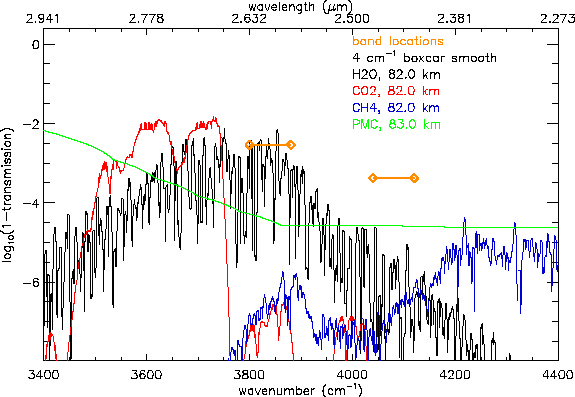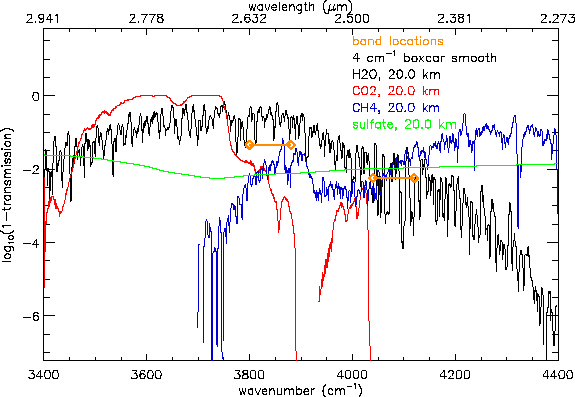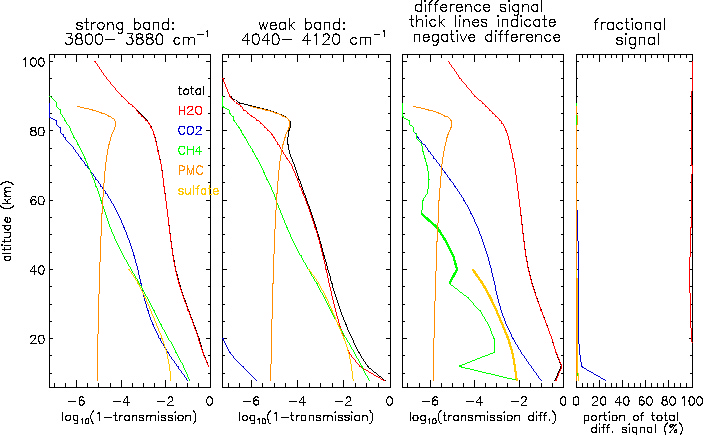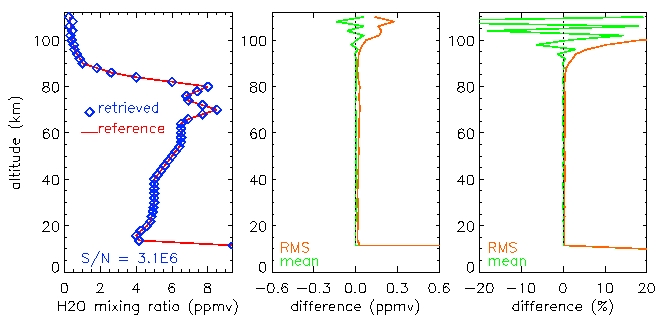SOFIE Water Vapor Channel
The H2O channel is located near 2.6
microns. PMCs will have no effect on H2O measurements in this
band.
Water Vapor Signal Simulations
Figures 1 and 2 shows simulated limb transmission spectra for
H2O, CH4, and CO2 using a climatological atmosphere
for 60N during summer. Also shown is a PMC spectra is based on an
average PMC size distribution and a path length of 250 km. The
proposed new H2O band is in a region of very little PMC absorption.
A region of strong CO2 absorption exists towards longer
wavelengths than the H2O region. CH4 interference exists at
wavenumbers greater than about 3800 1/cm. CO2 interference can be
minimized by locating the absorbing H2O band at wavenumbers greater
than about 3780 1/cm. This choice will result in some CH4
interference, however, the
CH4 signal is far weaker than the H2O signal. Locating the
non-absorbing H2O band toward greater wavenumbers than the H2O would
eliminate the
PMC induced difference signal.
For design reasons, the H2O bands were narrowed and separated.
Suggested band locations (see Figure 1):
strong: 3800 - 3880 1/cm
weak: 4040 - 4120 1/cm
Figure 3 shows simulated transmission profiles for the absorbing and
non-absorbing bands listed above, using a climatological atmosphere
for 60 degrees N latitude during summer. The PMC profile is from
an average of HALOE measurements, shifted in wavelength.
While there is gaseous interference in the weak band, it is
small. In fact, H2O dominates the total difference signal
at altitudes down to the tropopause. PMCs comprise less than 1%
of the difference
signal and thus should have little or no effect on SOFIE H2O retrievals
using this new band.
As seen in Figures 2 and 3, H2O dominates the signal even in the
stratosphere. The sulfate aerosol signals shown represent
background
conditions. Sulfate aerosols will have little effect on the SOFIE
H2O measurements. This band should provide H2O retrievals from
the
tropoause to 95 km.
In Figures 1 and 2 transmissions (t) are shown as log(1-t), so
that t = 0.9 corresponds to -1, t = 0.99 to -2, etc...
 Figure 1
Figure 1
 Figure 2
Figure 2
 Figure 3
Figure 3
Simulated SOFIE Water Vapor Retrievals
Simulated water vapor retrievals were conducted for a proposed SOFIE
H2O band located from 3800 to 3880 1/cm. These retrievals used a climatological atmosphere
for summer at 60 deg. N latitude to simulate a water vapor transmission
profile. This profile was then used as input for a limb
transmission onion peeling gas mixing ratio retrieval. The
retrieval assumed nothing about the instrument, except an
estimate of the measurement noise (1e-6). While the simulated
retrieval operates on transmission alone, SOFIE measurements will
yield difference signals. However, a transmission retrieval
assuming difference signal precission gives similar results to those
obtained from the inversion of difference signals. The simulated
retrieval is shown in Figure 4.
These results indicate that measurements using the proposed SOFIE H2O
band can be used to infer H2O mixing ratios at altitudes from the
tropopause
to about 95 km.
 Figure 4.
Figure 4.
Back to SOFIE channel selection
Back to SOFIE home
 Figure 1
Figure 1 Figure 2
Figure 2 Figure 3
Figure 3 Figure 4.
Figure 4.